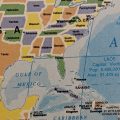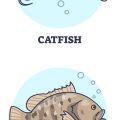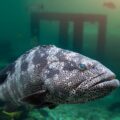The Blacktip Grouper, scientifically known as Epinephelus fasciatus, is a fish species belonging to the family Serranidae. This species is also commonly known by other names, such as blacktip rock cod, blacktip hind, and blacktip sea bass. Anglers and commercial fishers both highly prize this fish because of its distinctive and striking appearance.
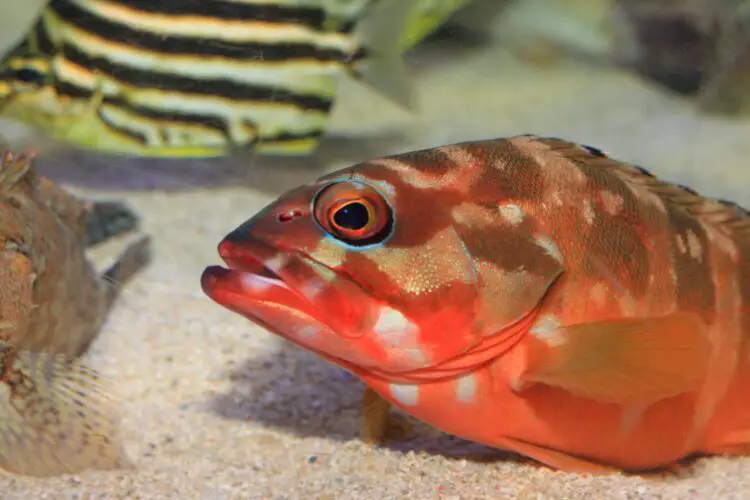
Blacktip grouper habitat and distribution
The Blacktip Grouper is primarily found in the Indo-Pacific region, which includes the Red Sea, the eastern coast of Africa, the western Pacific Ocean, and the Indian Ocean.
The Blacktip Grouper is commonly found in tropical and subtropical coral reef habitats, and it prefers areas with caves, ledges, and other structures where it can find shelter and ambush prey. The species is known to inhabit shallow waters of less than 10 meters to deeper offshore areas of up to 100 meters or more.
In the Red Sea, Blacktip Grouper can be found along the coast of Egypt and in the Gulf of Aqaba, where commercial and recreational fishermen commonly catch them. In the Arabian Sea, the species can be found along the coast of Oman and the Arabian Peninsula. It is also present in the waters around the Maldives, Sri Lanka, India, and Southeast Asia, including Indonesia, Malaysia, and the Philippines.
In the western Pacific, the Blacktip Grouper is distributed throughout the Coral Triangle region, which includes the waters around Indonesia, the Philippines, and Papua New Guinea. It can also be found in the waters around northern Australia, including the Great Barrier Reef.
In addition to coral reefs, the Blacktip Grouper can also be found in estuaries and river mouths, particularly when juvenile fish are developing. In some areas, such as the Mekong River in Southeast Asia, the species is known to migrate into freshwater environments during the breeding season.
How to distinguish a Blacktip Grouper?
The Blacktip Grouper has a distinctive appearance that sets it apart from other grouper species. It has a robust, oval-shaped body that is covered in small, diamond-shaped scales. The body coloration of the Blacktip Grouper is typically red or gray, with a series of vertical bars or stripes running down the sides of the body.
These bars are typically darker than the surrounding body coloration, and each bar has a black spot on the lower half. The head of the Blacktip Grouper is large and broad, with a steep profile that slopes downward from the forehead to the mouth. The mouth is wide and equipped with large, sharp teeth perfect for crushing and tearing apart prey.
One of the most distinguishing characteristics of the blacktip grouper is a prominent black spot on the dorsal fin. This spot is located towards the rear of the dorsal fin and is surrounded by a white or pale-yellow ring.
Another distinguishable feature of the Blacktip Grouper is a black spot on the caudal peduncle, which is the narrow area of the body located just ahead of the tail fin. This spot is surrounded by a pale yellow or white ring, which helps to highlight the spot and make it more visible.
When compared to other grouper species, the Blacktip Grouper has several unique characteristics that set it apart. For example, the black spot on the dorsal fin is a critical feature distinguishing it from other Grouper species, such as the Red Grouper (Epinephelus morio), which lacks this spot.
Additionally, the Blacktip Grouper has a more elongated and tapered body shape when compared to other grouper species, such as the Nassau Grouper (Epinephelus striatus), which has a more rounded body shape. The vertical bars on the sides of the body are also a distinguishing feature of the Blacktip Grouper and help to differentiate it from other species, such as the Goliath Grouper (Epinephelus itajara), which lacks these bars.
How long does a Blacktip Grouper grow?
The average size of a Blacktip Grouper is around 40-50 cm (16-20 inches) in length, and they typically weigh between 1-2 kg (2-4 pounds). However, they can grow much more extensive than this.
The maximum size recorded for this species is approximately 120 cm (47 inches) in length and 25 kg (55 pounds). The most enormous Blacktip Grouper ever caught was reportedly caught off the coast of Florida in the United States in 1998. This specimen weighed in at 124.18 kg (274 pounds) and measured 1.53 m (5 feet) in length.
In terms of size comparison with other grouper species, the Blacktip Grouper is relatively tiny. For example, the Goliath Grouper (Epinephelus itajara) can grow up to 2.5 m (8 feet) in length and weigh over 300 kg (660 pounds). The Atlantic Goliath Grouper (Epinephelus tamara) is another large species that can reach up to 2.3 m (7.5 feet) in length and weigh up to 360 kg (790 pounds).
Other smaller species of grouper include the Red Hind (Epinephelus guttatus) and the Yellowfin Grouper (Mycteroperca venenosa), which typically reach lengths of around 40-60 cm (16-24 inches).
Blacktip grouper diet
The Blacktip grouper is a carnivorous fish found in the Indo-Pacific region. The diet of the Blacktip grouper primarily consists of small fish, crustaceans, and cephalopods. They are opportunistic predators and will consume any prey that is available to them.
Several factors, including the time of day, location, and availability of prey, influence the feeding behavior of the Blacktip grouper. They are active predators that hunt during the day and prefer to ambush their prey from hiding spots in the reef.
Juvenile Blacktip groupers are known to feed on planktonic organisms such as copepods and mysids, while more significant adults prefer larger prey such as small fish, crustaceans, and cephalopods. They have large mouths with sharp teeth, which allows them to capture and swallow their prey easily.
Blacktip grouper reproductive habits
Blacktip Grouper is a protogynous hermaphrodite, which means that individuals typically start their lives as females and later transition to males. This process is called sequential hermaphroditism and is common in many grouper species.
During the spawning season, typically from May to September in the Western Atlantic, Blacktip Grouper gather in large aggregations near coral reefs and other structures. Males attract females by producing grunting sounds and courting displays, and the female then releases her eggs into the water column. The males then release their sperm, which fertilizes the eggs.
After fertilization, the eggs hatch into larvae that drift with the currents for several weeks before settling into their preferred habitats. Blacktip Grouper can live for up to 30 years, and their age at maturity varies depending on factors such as water temperature, habitat quality, and food availability. Females can lay up to 3 million eggs annually, depending on their size and age.
Comparing the reproductive habits of the Blacktip Grouper to other grouper species, it’s worth noting that different species have different spawning seasons, mating behaviors, and reproductive strategies. For example, some grouper species, such as the Nassau Grouper (Epinephelus striatus), form large spawning aggregations during the winter months, while others, such as the Yellowfin Grouper (Mycteroperca venenosa), have a more dispersed reproductive strategy.
Additionally, some grouper species are gonochoristic, which means that individuals are either male or female throughout their lives, while others, including Blacktip Grouper, are protogynous hermaphrodites. The timing and frequency of sex change can also vary among grouper species.
Is fishing for Blacktip Groupers allowed?
The population status of the Blacktip Grouper varies across its range, but it is considered overfished in many places. In some areas, the population is declining due to overfishing and habitat degradation, and there are concerns about the sustainability of the fishery.
The fishing and catch limit regulations for Blacktip Grouper vary depending on the country and jurisdiction. In general, there are restrictions on the size and number of fish that can be caught, and some areas may have closed seasons or regions where fishing is prohibited altogether.
For example, in the US, the National Marine Fisheries Service has established a total catch limit for Black Grouper and Gag Grouper, which includes the Blacktip Grouper, in the Gulf of Mexico. The recreational bag limit is two fish per person per day, with a minimum size limit of 24 inches in total length. Commercial fishing is also regulated, with a quota system in place to manage the overall catch.
In Australia, the catch of Blacktip Grouper is regulated by individual states and territories, with different bag and size limits in each region. For example, the minimum size limit in Queensland is 30 cm, and the daily bag limit is five fish per person. In contrast, the minimum size limit in Western Australia is 50 cm, and the regular bag limit is two fish per person.
It’s important to note that the regulations and catch limits for Blacktip Grouper can change over time, so it’s always advisable to check the local regulations before fishing for this species.
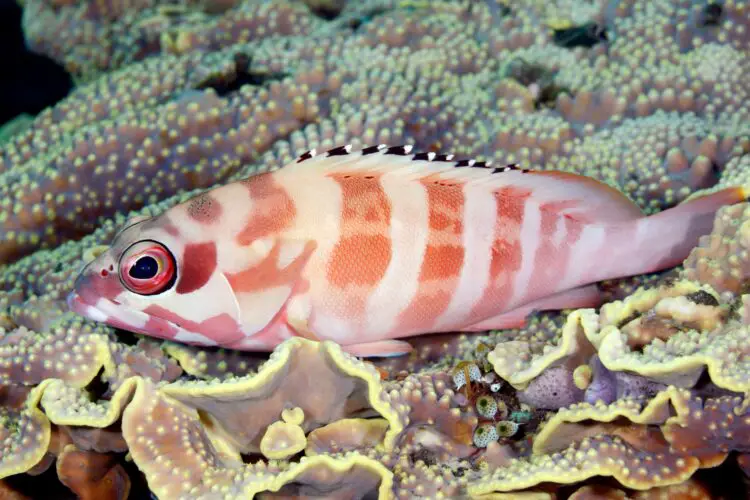
How does Blacktip grouper taste?
Seafood lovers highly prize Blacktip Grouper for its mild and sweet flavor, firm and flaky texture, and meatiness.
The meat of Blacktip Grouper is white and has a mild flavor that is often described as sweet and delicate. The texture is firm and flaky, which makes it ideal for grilling, baking, and frying. The fish has a moderate oil content, contributing to its moist and succulent flavor.
In terms of meatiness, blacktip grouper has a dense flesh often compared to that of snapper or bass. It is a versatile fish that can be cooked in many ways, including grilling, broiling, poaching, and sautéing.
Does Blacktip grouper taste better than other groupers?
Comparing the taste of Blacktip Grouper to other grouper species is subjective and can depend on personal preferences. However, this grouper species is not widely considered the best-tasting out of all the grouper species out there. Still, it’s worth noting that different grouper species have distinct flavors, textures, and culinary uses.
For example, Red Grouper is another popular grouper species often compared to Blacktip Grouper. Red grouper has a mild, slightly sweet flavor, similar to blacktip grouper, but with a slightly firmer texture. Red grouper is often considered the best-tasting grouper species by many seafood enthusiasts.
Other grouper species, such as Gag Grouper (Mycteroperca microlepis) and Yellowedge Grouper (Hyporthodus flavolimbatus), have a more robust and more savory flavor, with a firmer and denser texture. They are often used in hearty seafood dishes like stews and chowders.
In terms of culinary uses, blacktip grouper, like many other grouper species, is versatile and can be used for many dishes, including grilling, broiling, and baking. It is also commonly used in seafood soups and stews, where its firm texture holds up well in the cooking process.
What is the best way to cook Blacktip grouper?
Here is a step-by-step guide for grilling blacktip grouper:
Ingredients
- 4-6 Blacktip Grouper fillets
- 2 tablespoons olive oil
- Salt and pepper
- Lemon wedges for serving
Instructions
- Preheat a gas or charcoal grill to medium-high heat.
- Brush the Blacktip Grouper fillets with olive oil and season them generously with salt and pepper.
- Place the fillets on the grill, skin-side down, and cook for 4-5 minutes per side or until the flesh is opaque and flakes easily with a fork.
- Avoid overcooking the fish, as it can dry and lose flavor.
- Remove the fillets from the grill and serve them immediately, garnished with lemon wedges.
Alternative cooking methods
- Baking: Preheat the oven to 375°F. Place the seasoned Blacktip Grouper fillets in a baking dish and bake for 15-20 minutes until the flesh is opaque and flakes easily with a fork.
- Frying: Heat 1/4 inch of oil in a large skillet over medium-high heat. Dredge the Blacktip Grouper fillets in seasoned flour and shake off the excess. Fry the fillets for 3-4 minutes per side or until golden brown and cooked through.
That’s all you need to know about the Blacktip Grouper. They’re an interesting species of grouper worth learning about.

